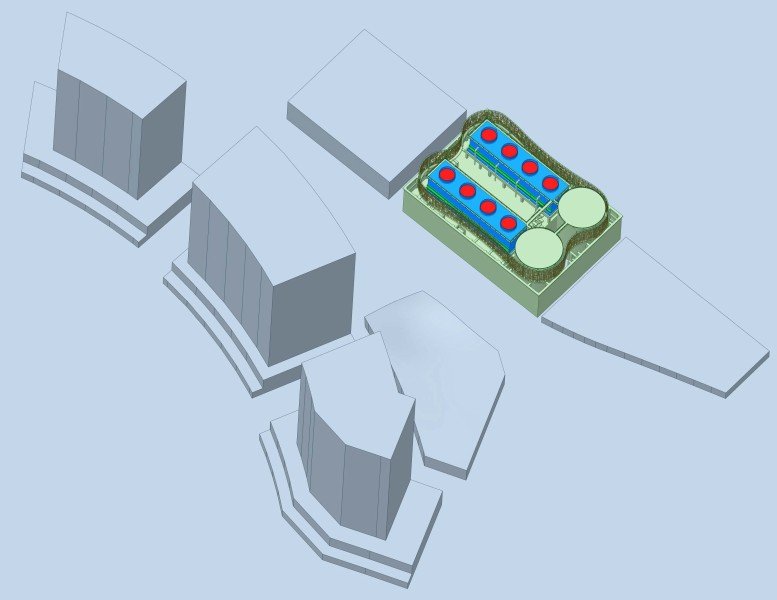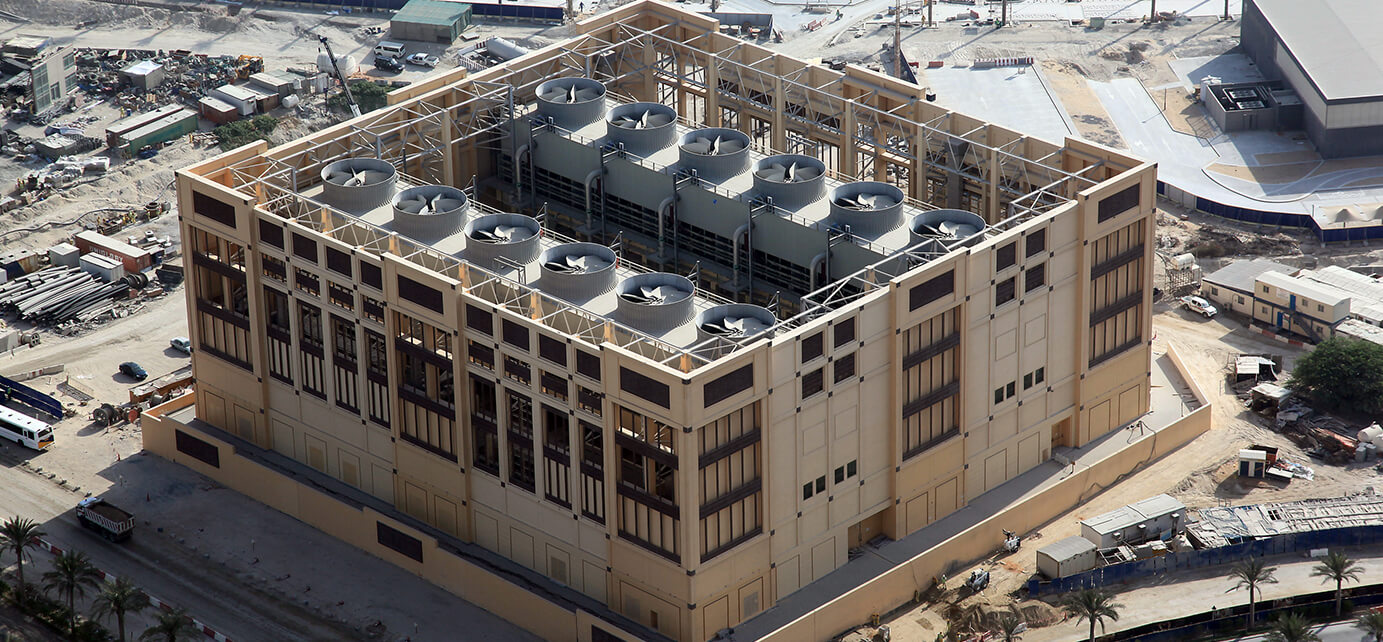
A district cooling plant has various high noise-generating MEP equipment, including various Pumps, Water chillers, cooling towers, HVAC equipment fans, AHU, FAHU, and FCU units at different levels of buildings. If the district cooling plants are located near the residential buildings, it is critical to maintain the noise levels as required by the building regulations.
This article will discuss one instance where Mechartés provided acoustic engineering & design consultancy for a district cooling plant project in the Middle East where we offered optimized solutions and design suggestions to reduce the noise impacts from all the sound-generating mechanical, electrical, and plumbing (MEP) units.
Let’s elaborate.
Performing Acoustic Analysis of Equipment at District Cooling Plant: An Overview
Acoustic analysis was carried out considering all equipment at different levels running simultaneously. Here’s a step-by-step analysis of the entire process:
1. Calculating Vibration Isolation
As the preliminary step, vibration isolation is calculated for all MEP equipment per ASHRAE standards. The objective of providing vibration isolation is to mitigate the vibration transferred to adjacent floors from all the equipment in operating condition. Subsequently, vibration, isolators, spring hangers, anti-vibration pads, and inertia bases for large pumps are provided based on ASHRAE guidelines.
2. Simulating Sound Levels with 3D Modelling
In this stage, the objective is to simulate the acoustic sound levels and plot noise mapping contours to check the noise propagation in the nearby residential buildings. As the next step, 3D modeling of the complete district cooling plant was done, and all the sound-generating equipment was marked as the sound source. The concrete walls, floor slab, doors, and windows are provided with transmission loss as per material characteristics.
Also, the sound absorbing characteristics of construction material and the directionality of sound propagation were simulated on software to determine the sound pressure levels breaking out through the district cooling plant boundary walls.
3. Evaluating Sound Levels as per Guidelines
The sound levels inside the building were checked in compliance with NC and RC criteria as per ASHRAE Chapter 48, Sound and Vibration Control.
For noise level in the nearby residential area and occupancy area, minimum LAeq are as follows:
● LAeq 55dB during the daytime 0700 to 2000 hrs.
● LAeq 45dB during the nighttime 2000 to 0700 hrs.
4. Executing Acoustic Analysis
To achieve adequate sound decibel levels, Acoustic analysis is done for the following two scenarios:
4.1. Case 1
Acoustic analysis is done with all equipment running simultaneously in the basement, ground floor, ground floor mezzanine, and lower roof with existing installation conditions.
4.2. Case 2
Acoustic analysis is performed with all equipment running simultaneously in the basement, ground floor, mezzanine, and lower roof with required sound attenuation measures.
The acoustic analysis was conducted by the SPPS method. The acoustic study is based on components such as:
● Architectural drawings for different levels of the district cooling plant.
● Critical rooms inside the district cooling plant.
● Nearby residential buildings as a plain receiver.
● Sound spectrum data at different octave bands for all HVAC and process equipment as given by the manufacturer.
● All equipment at different levels is in normal operating condition.
● Acceptable noise levels inside the building should satisfy the NC criteria mentioned in Section-1.
● The acceptable noise level in nearby residential areas should satisfy the equivalent sound level of 45 dBA.
3D Modelling Approach in the District Cooling Plant
A 3D model of the district cooling plant is modeled using Finite Element Analysis (FEA) software. All the rooms are modeled as per architectural drawings provided as input.
The image below shows different levels and a complete model of the building:
-
All HVAC and process equipment were modeled as a sound source. Sound from all equipment can propagate from all sides to the adjacent buildings.
-
Sound spectrum at different octave bands has been assigned to each piece of equipment as per the detail given by the manufacturer.
-
The number of receivers is modeled as a point to check the sound decibel level at different locations of adjacent buildings and different locations inside the building.
-
Plain receivers are modeled to capture the noise propagation in the nearby residential buildings, mosques, workshops, etc.

Sound transmission loss for different acoustic materials at different 1/3rd frequency octave bands is considered as given in ASHRAE chapter-48. Whereas sound and vibration control and engineering noise control by “David A Bies & Colin H Hansen” were considered in the study.
Achieving Key Results and Developing a Solution
Based on the 3D model and the inputs provided, the base case analysis was carried out for the existing design with all the equipment running simultaneously.
Drawing a Data-Driven Conclusion
It was found that the maximum sound decibel levels were higher than the allowable range as per the ASHRAE standards in all the nearby buildings, including the high-rise building area, Masjid area, Utility Building, and all other rooms, which range from 56 to 74 dBA.
Therefore, it was concluded from the results that acoustic noise levels are higher than the allowable range for nearby buildings, and the NC criteria levels for the rooms inside the DCP are higher than the acceptable range.
Identifying Optimal Solutions
As leading CFD, FEA, Piping, and Acoustic Analysis Consultants, Mechartes provided a slew of recommendations. These include the following:
1. Acoustic Louvres
We suggested installing Acoustic Louvers 1 meter above the cooling tower fans with a calculated value of sound transmission loss.
2. Sound attenuators
We also concluded that sound attenuators at the inlet and outlet of the FAHU, SMF & FAF should be added with a calculated value of sound transmission loss.
3. Enclosures and isolators
To reduce the noise from the Gensets, Acoustic Enclosures and vibration isolators were provided to reduce the breakout noise and structure-borne noise transmission.
4. Additional simulation with new modifications
Further simulation was carried out with the design modification, and the noise levels were calculated. The acoustic noise levels were now within the allowable range for high-rise buildings, Masjid areas, Utility Buildings, and all other rooms, ranging from 15 to 42 dBA.

Final Note
With Mechartés expertise in the CFD and numerical analysis and the recommendations mentioned, the client can come up with a conclusion on their design and way forward.
We at Mechartés focus on providing accurate simulation results with a professional engineering approach. Our biggest strength is our expertise and team of young, passionate engineers who work as a close-knit unit.
Feel free to get in touch with us. Write to us here.

